Plumeria Repot question
Hello
I'm new to the Plumeria Forum since I spend most of my forum time reading rose stuff.
BUT, I am the proud owner of a beautiful plumeria that grew from a "potted stick" that my dear friend gave me several years ago. (a couple of years ago, DH and I renewed our wedding vows in Hana and my wedding flowers were Plumeria; that trip really ruined me!)
Here's my questions - please help!
Since my Plumeria is now tall, branching and blooming, I am afraid that it has outgrown its pot. Is it ok to repot it??? I don't know if Plumeria is picky about having roots disturbed.
Thanx for your advice. This Plumeria is kinda like a member of our family, so I want to keep it healthy and happy. Jan
Comments (21)
plumeria_bill
17 years agolast modified: 9 years agoIf it isn't broken don't fix it. I would wait till spring. If it is top heavy sit it in a larger pot with sand between the two pots.
tdogdad
17 years agolast modified: 9 years agoPlumeria_bill is correct. You can transplant plumerias almost anytime and generally they are not easily disturbed, however when they are flowering they have a higher chance of shutting down the flowers until they adjust which usually means until next year. Plumerias can live in very small pots for several years. You can also put a same sized pot into the ground and drop your pot into it so the wind can't blow over your pot, or just bury your pot in the ground. I often put my small pots in between larger pots which hold them up until I get around to transplanting them. I like bills idea of the larger pot because you could use sand or rock or a combination to modify the heat. In the desert this might be too hot but most everywhere else it would work.
Related Professionals
Carson Landscape Architects & Landscape Designers · Forest Park Landscape Architects & Landscape Designers · Rancho Cordova Landscape Architects & Landscape Designers · Simi Valley Landscape Architects & Landscape Designers · Roxbury Crossing Landscape Architects & Landscape Designers · Burien Landscape Contractors · Essex Landscape Contractors · Fort Mill Landscape Contractors · La Verne Landscape Contractors · Cypress Siding & Exteriors · Downers Grove Siding & Exteriors · Kenosha Siding & Exteriors · Southampton Siding & Exteriors · Wayne Siding & Exteriors · North Reading Siding & Exteriorstdogdad
17 years agolast modified: 9 years agoHere is a picture of large and small pots of young plumies grouped together to withstand the wind and placed on rock to increase bottom heat.
{{gwi:1171055}}jeffsan73
11 years agolast modified: 9 years agoWe live in Yulee, Florida (North East area).
When is the best time of year to transplant our plumeria to a larger pot?
Our plumeria is on rollers so to move it in & out of the lanai for ease of seasonal coldness.
Also what nutients/soil/vitamins are good for plumerias?tapla (mid-Michigan, USDA z5b-6a)
11 years agolast modified: 9 years agoI agree that repotting should be put off until spring, just before buds move is best. There IS a difference between repotting and potting up, however, and you can pop up (transplant) any time without concern for notable set back.
I always prefer to repot instead of potting up, but there are times when I can't get to all my repots, or I acquire a tree that's root bound and when it's not appropriate to repot. In those cases, I think I'm a little more aggressive about the procedure than most, and I've never had an adverse reaction in plants I've potted up, so I'll describe how I do it.
Usually, when you depot a root bound plant, you'll find a large mass of roots circling the root mass at the bottom of the pot. You can see this 'band' of roots at the very bottom of the root masses in some of the pictures below. With my hands, and not very carefully, I separate these from the main root mass and cut them off, along with an inch or two of soil at the bottom of the pot; how much, depends on how large the root ball is. Then, I take a utility knife with a very sharp blade and make vertical cuts in the root mass to the full depth of the blade - about an inch. That completed, I pot the plant in a slightly larger pot, setting the root ball on top of some soil added to the bottom of the pot and filling in around the sides. Use a soil similar to what the plant is in. It's best to avoid dissimilar soils in the same pot. If you plan on changing to a highly aerated soil that drains freely, like many growers prefer, it's best to make the change at repot time when you bare-root the plant and do your root pruning.
Most growers are reluctant to mess with roots because they fear killing the plant, but you'd be very surprised at what you can do to a plant if you follow some simple repotting procedures. Here are a couple of before/after pictures of the typical root reductions my plants undergo at repot time. Sorry they're not plumies, but there is no reason to suspect plumerias might react adversely to the same treatment.
A little boxwood pre-bonsai, from this
{{gwi:659}}to this
{{gwi:661}}A trident maple
{{gwi:6332}}Finally, a Ficus:
{{gwi:80441}}Instead of weakening a plant when you root prune, you invigorate it. There is a physiological reason for this that has to do with the ontogenetical age of the plant tissues. While we age chronologically, plant tissues age ontogenetically. The tissues farthest from the transition zone between roots and shoots, even though they are the youngest on the plant, are the oldest and weakest. The tissues closest to the root/shoot transition are the most vigorous, so when we prune roots back to more vigorous tissue, we get much stronger root growth. What we end up with is a pot full of strong, fine roots, and it's the fine roots that do all the work. Heavy roots in pots are essentially useless. They take up space that COULD be occupied by more beneficial roots and limit your plant's potential. With a little determination, you can fix that.
About disturbing roots when you're potting up ..... I know some would be reluctant to follow the procedure I described - ripping the bottom of the root mass off and scoring the sides, but it's not w/o consideration or reason I offer the suggestion. First, if you look at those roots at the bottom, you'll see they're essentially devoid of root hairs and of little use to the plant. Second, removing them sends a chemical signal to the plant to funnel it's energy toward root growth. Blooms are the plants strongest sink, and roots its weakest, so it won't take energy from blooms. All that happens is branch extension and foliage growth slows imperceptibly for a short time while the severed roots begin to bifurcate into smaller roots. The end result from the potting up as I described it is a plant that is returned quite a bit closer to its potential for growth and vitality than a plant you simply took from one pot and plopped into a larger pot.
As seen in other threads, potting up is a stop gap measure that only partially returns a plant to it's potential for growth/vitality. Repotting, along with the root work that accompanies it, fully restores the plants potential, within the governance of other factors that have the potential to limit growth, of course.
Al
tapla (mid-Michigan, USDA z5b-6a)
11 years agolast modified: 9 years agoThis tropical plant, Eugenia myrtifolia, is one I potted up today, mainly so I could illustrate what I was relating above.
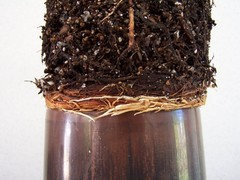
You can see the band of roots at the bottom I referred to that are beginning to wrap around the inside of the container walls. The strength of this plant (very strong) is evident in the condition of the roots - especially since they were in a dark colored plastic pot in mid-summer.With only a little help from me, The roots come loose from the root mass and hang by the roots that are supporting the lower roots.
{{gwi:97529}}You can also see I pruned off about 90% of the tree's foliage in its second step toward becoming a bonsai. Then, I used a sharp pair of scissors or pruners to cut the bottom mass off here.
{{gwi:97528}}Then, add a little soil to the bottom of a larger pot and fill in around the sides to complete the potting up.
IF, the roots of this plant would have been congested to the degree the first two plants pictured above were, I would have scored the root mass with a utility knife as described before potting up.
The above plant is on the borderline between actually needing a full repot or a simple potting up. If you catch your plants early, before the root/soil mass can be lifted from the pot intact, you CAN pot up repeatedly with no ill effects. But once plants get to the state of root congestion you see in the post above, growth and vitality are permanently affected. All those intertwined roots you see in the post above get larger and larger, choking each other off. As that occurs, you have a very small mass of fine roots on the perimeter of the main root mass trying desperately to support a large above ground mass. Vitality and growth wanes - especially branch extension. The ability of the plant to store nutrients wanes. Defenses wane, leaving the plant increasingly vulnerable to insect predation and disease. The plant develops the 'look' of a rootbound plant that is immediately apparent to an eye used to observing the effects of tight roots on growth habit.
I hope that was helpful.
Al
wally_1936
11 years agolast modified: 9 years agoIf it is root bound I can not see waiting. When you take it out of its pot everything will come with the plant. As long as you have another pot with some soil in the bottom you only need to take care in filling around the plant with good soil and watering in to make sure the soil settles around the plant and holds it secure.
citizen_insane
11 years agolast modified: 9 years agoHi Al,
all the pictures you are showing are bonsai. I am courious, are you growing any plumerias? Are you familiar with how plumerias grow roots? I would not cut a plumeria rootball in the middle across like your pictures show. You can easily ruin the plant because you do not know how deep the cutting was planted when the plumeria was rooted.Here is how plumerias grow roots. The pictures below show a side view and a bottom view of a 4-month old rooted cutting. As you can see all the primary roots emanate around the cambium line and point outwards. They hit the pot wall and bend up and down. A lot of side roots develop from these primary roots around the cambium line and fill the pot.


Here is a two year old plant and its cut-away view. The roots were cut back so you can see clearly. All the primary roots emanate around the cambium line and are anchored on new wood that grows over the old cutting wood.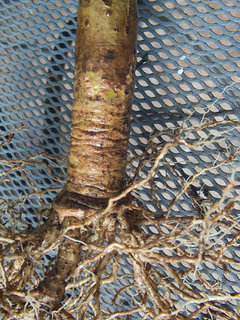
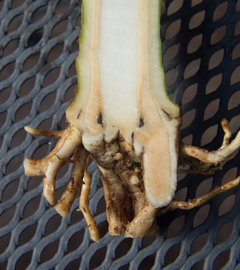
Here is a four year old plant. Same thing.
Here is a 7-year old plant. Same thing.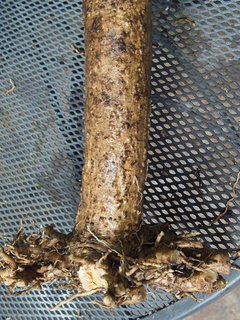
Here are the two cut-away halfs of the 7-year old plumeria. The bottom of the cutting is solid wood, 1.25" thick. All primary roots emanate from the cambium line and point outward.

Note some things that are very important in re-potting:
1) All primary roots emanate at the cambium line and point outward.
2) No roots ever develop from the side of the bark!
3) Not many roots develop from the bottom of the cutting where the soft white core was. There is no tap root to rotate around the bottom of the pot.
4) No new primary roots ever develop as the plumeria gets older! All primary roots develop during the rooting process,
5) The plumeria rootball that fills the pot is mostly secondary roots that grow from the side of primary roots.Thus, cutting the bottom half of the rootball of a plumeria serves no purpose. You run the risk of severing the primary roots off and really damaging the plant. You do not know where the bottom of the cutting is when you cut. The only cuts that are meaningful in prunning roots of a plumeria are vertical cuts around the perimeter of the pot.
Hey bud, I am not citical. I am just trying to share something I know for a fact. I wrote an artice about this in the July issue of the PSA Plumeria Potpourri.
tc,
GeorgeLoveplants2 8b Virginia Beach, Virginia
11 years agolast modified: 9 years agoHello Everyone,
I just wanted to add how i rootprune my Trees. Its like receiving a bare rooted tree in a way.
This Celadine was the last of my trees to not want to "wake up " like the rest of my trees. I knew it was a mess from the year before, so when it showed signs of being silent and slow, i decided to do a full repot and rootprune on this Celadine. Since i have done this full repot and rootprune it has finally made a nice comeback and i feel good about what i have done. I have done this on lots of my trees and i do take off the bottom 1/3 of the rootball and i do trim the sides of the pots. If i was to "pot up" then i would give some cuts to the side of the trees and then pot up into a larger container.
Here are some of the pics...
ready to be repotted...
before pruning..
{{gwi:30044}}
started to cut..
{{gwi:30046}}
cut a little more...
{{gwi:30048}}
trimmed the sides
{{gwi:30050}}
after cuttinng 1/3 off the bottom and around 2 inches from the sides...
{{gwi:30052}}
soaked the soil off of the roots...
{{gwi:30054}}now i have roots that i can see and repot...
{{gwi:30055}}
{{gwi:30056}}
ready for my Gritty Mix... container ready.. mix ready too!
{{gwi:30057}}
Gritty mix ready,,
{{gwi:30058}}
newly planted tree in the Gritty Mix.. Looking very happy!!
{{gwi:30059}}I need to take a pic of this Celadine later to show you all how it has responded to my Major rootpruning..
I have done this with a lot of my trees and they love to have the roots pruned...
I just wanted to share my experience with pruning and how i do mine...
I hope this helps some of you all..
Here is my J-105 blooming at the moment.. thought you might like a peek!!! : )
{{gwi:30060}}
California Sunset
{{gwi:30061}}Have a great day everyone!!!
Laura
tapla (mid-Michigan, USDA z5b-6a)
11 years agolast modified: 9 years agoLet's try to stay focused on the original topic and not change it to something else for now, then we can discuss the methodology of repotting if you like. The plants I repotted weren't bonsai. They were normal trees in nursery cans or other deep pots that are being grown on as candidates for bonsai in the future. They had had some rudimentary pruning to help establish their future shape. Bonsai don't grow differently than other plants, including plumeria - it's just that plumeria don't make acceptable candidates for realistic bonsai.
I don't want the conversation to turn contentious, but there is still the explanation about why you feel plants in large pots aren't affected by tight roots that needs clarification. Changing the subject is a favored tactic when someone feels the pressure of an inability to support a position.
I also think that Laura's pictures speak for themselves. She seemed to have no problem after essentially doing to her tree(s) what I previously described, which in practical terms sort of makes your objections moot. Obviously she whacked the bottom third of the root mass with a fair degree of impunity.
While no cutting EVER develops a radicle (tap) root, they ALL develop secondary roots that serve the same purpose as a radicle - anchorage. .... and as far as I know, geotropism still rules the growth habit of plumeria roots, so they grow downward unless the cultural conditions they encounter are not conducive to growth. I mean, how far CAN they grow horizontally in a pot before they have to make a turn up or down. Reason alone, not to mention the pictures immediately above, is sufficient to bring us to the conclusion it's fine to chop off the bottom 1/3 of the roots.
Let me say though that that's not a requirement. If anyone thinks the roots in the pot grew upward instead of downward, simply bare root the plant BEFORE you start root pruning. You'll soon discover that the idea you'll be cutting all the roots off is unfounded, and that it's much easier if you start by sawing off the bottom of the root mass - but we all need to seek our own comfort level.
I've been repotting my own trees and other people's trees when they bring them to me for more than 20 years, so I fully understand the value of repotting VS potting up, and especially the contrast between trees left to languish in the same pot/soil for years. It's difficult to imagine how someone who doesn't adhere to the practice of full repots would argue against it w/o having observed its benefits in practical application. We're hearing what you think might be true, and what I know to be true - and it's supported by science, reason, and my own hands-on experience.
I'm not a plumeria expert. I grow a couple that were sent to me in return for a kindness I extended to another. I only grow them so I can understand their growth habits and be of more help to others. But I do have a grasp of trees and repotting that keeps me fairly busy addressing groups and showing them/explaining how to add to their skills as they pertain to maintaining trees in pots. BTW - I too have been published several times and some of my writings and ideas incorporated into the works of others with permission, but I'm more than happy to rely on my ability to make sense as the tipping point for other's decisions. I'm not debating you because how you treat your trees matters to me, it's because I don't want others to be misinformed. It's my habit to only involve myself in conversations when I'm certain I'm on solid ground and I can explain my reasoning. I'm not grasping at straws here. Every one of the list of 5 points you made above are moot to the conversation. If you'd like, I can explain WHY they are moot w/o vagary. That would be a strong statement from someone who might not be too sure of himself.
There is just no way to support the contention that our trees won't benefit from a well-timed full repot/root pruning; and as far as the methodology involved, let me say that I've been repotting trees for about 25 years, and teaching others (through invitations to address various groups and at forum sites) for at least 12-15 years, so when someone who seemingly has no experience repotting and root pruning (if you did, you wouldn't be arguing against the practice) suggests that I somehow don't understand the concept, I can't help but smile.
That's the view from here. YMMV, but let me know if you're interested in hearing my thoughts on your list.
Al
citizen_insane
11 years agolast modified: 9 years agoHi Al,
I think you totally misanderstood what I am trying to tell you. I am not against repotting. In fact I repot my plumerias all the time. I have more than 300 plants of ages from new all the way to 30 years old. I start cuttings in one or two gallon pots and pot them up as they grow older to 3, 5, 7, 10, 15 and finally 25 gallons. All my large plumerias are grown in 25 gallons pots. I had two in 50 gallon pots but they were way too heavy to move and I got rid of them. So, most of the time I do not cut roots because I pot them up before their roots really get crowded. Sometimes, if their roots are too crowded I do cut them. But I remove the soil around and cut individual major roots rather than shave off a section of the rootball.You also misunderstood the point of the five points I made. I did figure correctly that you do not have much experience growing plumerias. Plumerias are very different from other plants. They are very tough plants and can survive for years without a drop of water. Their worst enemy is keeping their roots too wet. The point I was making is that there are no major roots going to the bottom of the pot straight down. All the major roots grow outwards and then bend and grow up and down. Yes, plumeria roots grow up and fill the whole pot. Look at Laura's pictures, they show it. So if you cut around the perimeter of the pot you cut the source of most of the bottom roots. So, cutting around the perimeter is a lot more important than cutting the bottom of the rootball. If you do not cut around the perimeter you are not doing much good. I was also making the point to be very careful if you cut across the rootball not to cut near the bottom of the cutting, which will do some major damage to the plant. The other point I was making is that if you use a 25-gallon pot the major roots do not get crowded for a long time and the plant does relatively good even being root bound. I do not let my plants get very root bound when planted in small pots.
Now, in Laura's case, my oppinion is that the size of the pot (I figure about 3 gallons from the pictures) is way too small for the size of her plumerias. Look at the rootball left after trimming it and compare it to the size of the pot. That plumeria will need root prunning next year too. Secondary plumeria roots grow long very fast. Rooted cuttings fill a one gallons pot with roots in just a few months. Plumerias are trees in their native lands, they are not shrubs. In my oppinion, Laura is trying to grow them almost like a bonsai. I would pot up that plumeria into a 5-gallon wide squat pot. Then it will not need repotting for a while and the plant will grow better. Now, I can understand why Laura is growing her plumerias in such small pots. She lives in Virginia and keeps her plumerias in a greenhouse in the winter. She has many plumeria plants, so there is no room in the greenhouse to pot up her plumerias. She prefers to have more varieties in smaller pots than fewer varieties in bigger pots. Most people, in other areas, do not grow plumerias like Laura. Here in the Houston area a lot of people plant them in the ground and dig them up in late November and hang them from the rafters in their garage. They use a sharp shooter spade to cut a circle of about 14" in diameter around the plant. You see the rootball of those plumerias is not very big (smaller than a basketball). They remove all the soil and wrap the rootball with a plstic sheet before hanging them. Others grow them in pots and sink them in the ground. Those do not need big pots or often root prunning because the plants get most of their nutrients from roots that grow out the the holes in the bottom of the pots. The pots make it convient to lift the plumerias for winter storage by just cutting the roots around the pot. Others grow them in pots around their pool. This is the case you need a good size pot. Not only the plants grow better in large pots, but they also withstand storms and wind much better (have low center of gravity due to the weight of the pot). Plumerias in small pots get blown down by wind very easily. Have you ever seen what happens when a plumeria gets blown into the pool?
You are trying to generalize experience with other plants to plumerias; now that is dangerous because plumerias are very different from other plants. Everybody has their reasons for what they are doing and you cannot generalize and say it is wrong because it is different from what you would do. I have no problem with what Laura is doing. I most likely would do the same thing had I been in the same situation.
tc bud,
Georgetapla (mid-Michigan, USDA z5b-6a)
11 years agolast modified: 9 years agoEveryone that specializes in a particular type of plant THINKS their plant is markedly different from every other - it isn't. I hear this same claim at least once per week on one of the forums. The fact that you think the roots of plumeria have a unique growth habit is well wide of the mark. They actually look remarkably like most Moraceous plants, which would include ficus and mulberry. As well, plants are remarkably the same in their likes and dislikes, and what a plant will tolerate is not a good measure of it's preferences.
I freely admit to not being an expert on plumerias, but I do consider myself to have a great deal of expertise when it comes to container culture and repotting/root pruning. I've been studying it, practicing it, and teaching it for many years, so I'm pretty sure I have a distinct advantage when it comes to discussions that involve container culture and long term maintenance of woody material in containers. Too, I'm not generalizing in my offerings, either, I'm being painfully specific. Plumerias are no different than any other plant when grown in conventional container culture, even if you don't realize it yet, and introducing a lot of variables and what ifs to the conversation simply muddies the water. We're losing focus because of the new supply of variables introduced with each of your offerings.
Allowing the fact that roots USUALLY emerge only from the basal end of the cutting, it's a simple matter of removing enough soil to see where the roots begin to gauge whether or not it's safe to cut at any given point below where the roots emerge. That should be a part of every repot anyway - so the grower knows how deep to pot the plant. I'm not saying this in a mean or sarcastic way, but I can tell from your description of your version of root pruning that what you have been doing is much closer to potting up than repotting. Root pruning concentrates on removing roots in the center of the root mass (think of a hungry beaver gnawing its way up through the center of the root mass to just below the trunk). All heavy lateral roots are kept (plumbing), but at some point they are pruned immediately distal to a finer root that will do the plant some good.
Finally, I never said what you or anyone else does is wrong - that's not how I roll. My only interest is that people have the information they need to decide what is or isn't right or wrong for them.
In this particular case, the facts ARE black and white and are what should be used in the balance when making decisions. Tight roots affect growth and vitality. Period, There is no getting around that fact. Potting up - shaving the outside of the root ball and pruning a root here and there will PARTIALLY restore a plant's potential for growth, but won't offer the best results. Repotting and an accompanying root pruning physiologically rejuvenates the root system and restores the plant to its full potential for growth/vitality within the limits of other cultural factors that have the potential to be limiting. Shades of grey are only introduced when something other than the plants well-being takes precedence. Examples - I want to see if being root bound makes the plant bloom better, repotting would be too difficult, I would have to give up an afternoon ..... These are things we weigh in the balance and are the shades of gray, but notice how none of them involve the plant's well being.
If people want to consider allowing their plant go for another year before repotting or potting up, they should have the information they need to make that decision. Someone telling them it's ok when it isn't, isn't helpful to their growing experience. The fact is, if your plant is rootbound to the point that you can lift the plant from the container with roots and soil intact, the condition of the roots is limiting the plant, and it can't get better without the grower being proactive.
I've helped hundreds & hundreds of people turn their root bound plants completely around by way of a full repot. There is simply no basis to believe that plumeria are any different in how they respond to tight roots or to root pruning. If you think about it for a moment, you'll realize that the suggestion that plumeria are unique among all plants in that regard even sounds far fetched.
I'm more than happy to let the real plumeria experts answer the questions about subtleties that pertain to the plant and various cultivars, the little tricks that really ARE unique to the plant, but when it comes to the physiology of woody plants and their care under container culture, I'm well-qualified to offer definitive help, in fact, I get paid for it.
Al
Oh - about Laura's plumerias - she does very well for herself from what I've seen - a big heart, too. You suggest her pots are too small - not true unless she allows her plants to become root bound. It might be EASIER on her in that she wouldn't need to repot so often, but that's where the shades of gray come in. She understands the facts and is deciding what's best for Laura, based on those facts, which is the best course in my estimation. There is no inhibition of growth or reduction in vitality associated with a small pot unless the roots are tight in it - unless we drift afield further and start talking about other cultural influences like temperatures, which wouldn't help this conversation.
jandey1
11 years agolast modified: 9 years agoJan, plumeria are resilient. I've been repotting several in the middle of our blazing summer and they're fine. However, if yours is blooming, listen to Bill and don't disturb it. Early spring is the optimum repotting time, and yes, it will make your beloved plant happier to be in a more spacious pot.
The rest of you--I'm just whistling nervously and standing well back. ;)
mksmth zone 7a Tulsa Oklahoma
11 years agolast modified: 9 years agoAll this arguing back and forth about "who" is right is getting tiresome and turning me off from this forum. I come here to enjoy others plants not have to scroll past the bickering about what method is right and what method is wrong.
Being a relatively new grower of container plants I can appreciate the information and experience of all who contribute but I cant stand to feel as if its being forced down my throat. My opinion, if Im allowed to have one, is that you have both made your point and its time to move on.
Mike
citizen_insane
11 years agolast modified: 9 years agoHi Laura,
I could not stop laughing this morning when I read your post. The "Bonsai" comment was meant as a joke. I am glad you had a good laugh.Wow, I did not know you had those large plumerias and that you have that many plants. Do you really keep those large plumerias in the bedroom? If I did that, my plumerias and I would end up in the front lawn by morning. lol.
Your plumerias look good. Plumerias like cooler wheather. When we get intervals of cooler weather in Houston the plumeria blooms get much bigger in size.
Hey Jen, you don't have to do that. We just had a good debate with my pal Al. We have already declared a truce in the other thread.
Here are some of my latest blooms.
Charlotte Ebert (one of the largest flowers)

Backlit Charlotte Ebert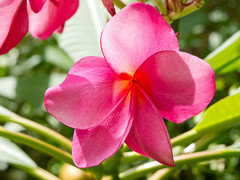
Ryan Chelsey
Islamorada
Duke
Hurricane
Donald Angus
Lemon Drop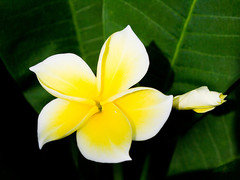
tc,
GeorgeAndrew Scott
11 years agolast modified: 9 years agoHi George. I am so glad you and Al both declared a cease fire! It is apparent that both of you have your points, and both of you have grown in containers long enough to observe what has really worked and hasn't worked for your plants and trees.
I also agree that it is counter productive to argue and to have heated conversations here. We all love a good debate as long as we all can agree to play nice, and to not deliberatly hurt any of the other members here.
Were all respected here and I hoper that continues..cmon this is the plumeria forum. We need the true meaning of Aloha to permeat thru this group! I have always said that this is the nicest and by far(I.M.O.)my favorite G.W. forum.
Hi Laura,
Thanks so much for posting here. I truly believe that the best way to learn from one another is to not only talk about what has worked best for that person but to SEE what has worked best. Your pictures are always valued here and I hope you continue to post them.
You along with so many others here have truly been my inspiration when it comes to growing these truly tropical treasures!I just wanted to say that I totally use the same root pruning techniques. As of now, the only tree that I have touched in terms of root pruning is my Dwarf Singapore Pink. I took that tree from a 2 gal and potted it into a 3 gal(I believe it's a 5 gal...lol!)pot.
I did the same stuff you did...root ball reduction. I removed about 1/3 of the bottom of the rootball and then I removed as much of the soil I could from the rootball itself. I then pruned off any dead/damaged roots, and then I soaked the rootball in Vitamin B-1 siolution. I soaked the rootball for about 15 min to a half 30, then repotted it. I left the plumeria in part shade for the 1st few days just in case it responded to the root pruning by going into shock.
It really didn't drop leaves, and in fact, it held the 4 inflos it was developing/growing, and now 2 of the 4 are in full bloom, and the other 2 are just now maturing a few of there buds.
I know I have only been growing plumeria noe for about 3 years and I still have a lot to learn but so far, i am pretty happy with my results.
Learning how to be successfull at rooting was a huge challenge for me that I have overcome now, and even though I have had my failures, I have been sucessfull about 95% of the time.
Lastly I think it is important for newbies to realize that when it comes to seeing all this new info, just read and re read all these posts. Then try to figure out what methods have worked for most of the group, and try it!
This is how I started out, and thankfully it worked for me. I wish all the newbies the best of luck on there repotting.
Take care,
AndrewDave in NoVA • N. Virginia • zone 7A
11 years agolast modified: 9 years agoJust throwing in my comments and some questions too!
I do a lot of 'potting-up' over the summer--really anytime of the summer and have had no problems. Usually I'm potting up newer (but well-rooted) cuttings from 1 gallons to maybe 3 gallons or similar. As long as I am able to keep the rootballs intact and am careful to do minimal root damage in the process, my plumerias have not skipped a beat. Of course our high humidity probably helps the plant recover.
As for root-pruning, according to what I've gleaned, that is best done in late Winter, early spring before buds get glossy and begin growth. Honestly, I've not done this much yet, because I haven't had the time, but I will be forced to do it this next Spring!
Has anyone made any observations on how root-pruning affects plumeria growth and blooming in the following summer season? Does it increase the softer vegetative growth (which we know is not good for inflo formation)? Does it slow blooming and inflo formation? Does it not affect blooming at all? Or does it increase blooming?? I'm talking mostly about really large and mature plants.
Thanks all!
moonie_57 (8 NC)
11 years agolast modified: 9 years agoGeorge - thanks for posting your Charlotte Ebert. That is one beautiful flower! I have been wanting her since the beginning of spring but ran into one problem after another trying to obtain her. 2 weeks ago I was finally able to place the order but have not heard anything since. I'm beginning to believe she isn't meant to be. Not for me at least! LOL
Dave - I'm interested in responses to your questions. I have a couple of plants that need to be potted up from 3 to 5 gallon but 1 is flowering now (and has been since early spring) and the other has an inflo. Next spring is when I'm looking to do the job and had the same questions in mind.
citizen_insane
11 years agolast modified: 9 years agobeachplant
11 years agolast modified: 9 years agoMoonie, there are a couple of cuttings of Charlotte Ebert in your box. :)
George, Ernesto may be headed to the Gulf so we'll be watching closely. It would be nice to get some rain, but not 20-30 inches!
Dave, I am no help, everything gets planted in the garden. No need to root prune.
Mike, thank you, it is annoying.
I have repotted plumeria in full bloom and they have not shown any effect, I also repot them in the middle of summer, plant them in the flower beds, whack at them, sometimes with a machete.....they are a very tough and forgiving plant.
What I want to know is how you keep those plumeria so small. My 10' tree was 10' wide, and it was a small one in my hood before the hurricane/freeze got them all. Do you prune the side branches? Tie them up? I am so curious about these tall skinny trees.
Tally HO!


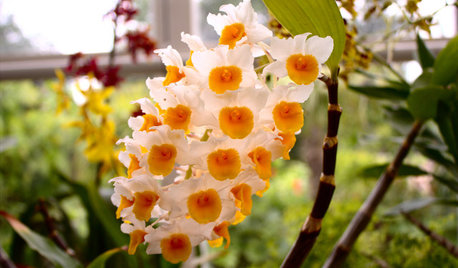













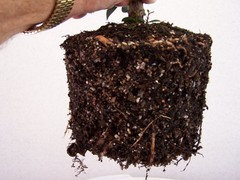
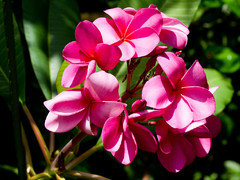
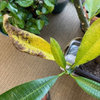
Loveplants2 8b Virginia Beach, Virginia